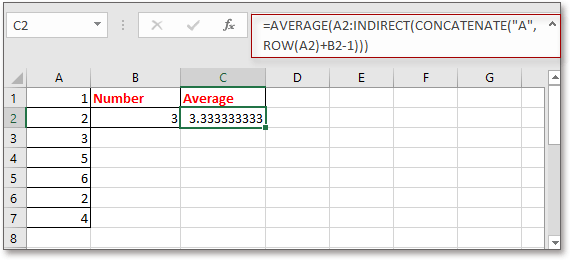Как определить диапазон на основе значения другой ячейки в Excel?
Для большинства пользователей Excel вычисление диапазона значений не составляет труда, но пробовали ли вы когда-нибудь вычислить диапазон значений на основе числа в определенной ячейке? Например, у нас есть столбец значений в столбце A, и мы хотим подсчитать количество значений в столбце A на основе значения в ячейке B2. Это означает, что если в B2 указано число 4, то мы найдем среднее значение первых четырех значений в столбце A, как показано на скриншоте ниже. Сейчас я представлю простую формулу для быстрого определения диапазона на основе значения другой ячейки в Excel.
Определение диапазона на основе значения ячейки
 Определение диапазона на основе значения ячейки
Определение диапазона на основе значения ячейки
Чтобы выполнить вычисления для диапазона на основе значения другой ячейки, вы можете использовать простую формулу.
Выберите пустую ячейку, куда вы хотите поместить результат, и введите эту формулу =AVERAGE(A1:INDIRECT(CONCATENATE("A",B2))), затем нажмите Enter для получения результата.
1. В формуле A1 — это первая ячейка в столбце, который вы хотите вычислить, A — это столбец, по которому производится расчет, а B2 — это ячейка, на основе которой выполняется расчет. Вы можете изменить эти ссылки по своему усмотрению.
2. Если вы хотите выполнить суммирование, вы можете использовать эту формулу =SUM(A1:INDIRECT(CONCATENATE("A",B2))).
3. Если первое значение, которое вы хотите определить, не находится в первой строке Excel, например, в ячейке A2, вы можете использовать следующую формулу: =AVERAGE(A2:INDIRECT(CONCATENATE("A",ROW(A2)+B2-1))).
Быстро подсчитать/просуммировать ячейки по фону или цвету формата в Excel |
В некоторых случаях у вас может быть диапазон ячеек с множеством цветов, и вам нужно подсчитать или просуммировать значения на основе одинакового цвета. Как быстро выполнить расчет? С помощью Kutools для Excel's Подсчет по цвету, вы можете быстро выполнять множество вычислений по цвету, а также генерировать отчет о результатах расчета. Скачайте Kutools и попробуйте прямо сейчас! |
Kutools для Excel - Усильте Excel более чем 300 необходимыми инструментами. Наслаждайтесь постоянно бесплатными функциями ИИ! Получите прямо сейчас |
Лучшие инструменты для повышения продуктивности в Office
Повысьте свои навыки работы в Excel с помощью Kutools для Excel и ощутите эффективность на новом уровне. Kutools для Excel предлагает более300 расширенных функций для повышения производительности и экономии времени. Нажмите здесь, чтобы выбрать функцию, которая вам нужнее всего...
Office Tab добавляет вкладки в Office и делает вашу работу намного проще
- Включите режим вкладок для редактирования и чтения в Word, Excel, PowerPoint, Publisher, Access, Visio и Project.
- Открывайте и создавайте несколько документов во вкладках одного окна вместо новых отдельных окон.
- Увеличьте свою продуктивность на50% и уменьшите количество щелчков мышью на сотни ежедневно!
Все надстройки Kutools. Один установщик
Пакет Kutools for Office включает надстройки для Excel, Word, Outlook и PowerPoint, а также Office Tab Pro — идеально для команд, работающих в разных приложениях Office.
- Комплексный набор — надстройки для Excel, Word, Outlook и PowerPoint плюс Office Tab Pro
- Один установщик, одна лицензия — настройка занимает считанные минуты (MSI-совместимо)
- Совместная работа — максимальная эффективность между приложениями Office
- 30-дневная полнофункциональная пробная версия — без регистрации и кредитной карты
- Лучшее соотношение цены и качества — экономия по сравнению с покупкой отдельных надстроек